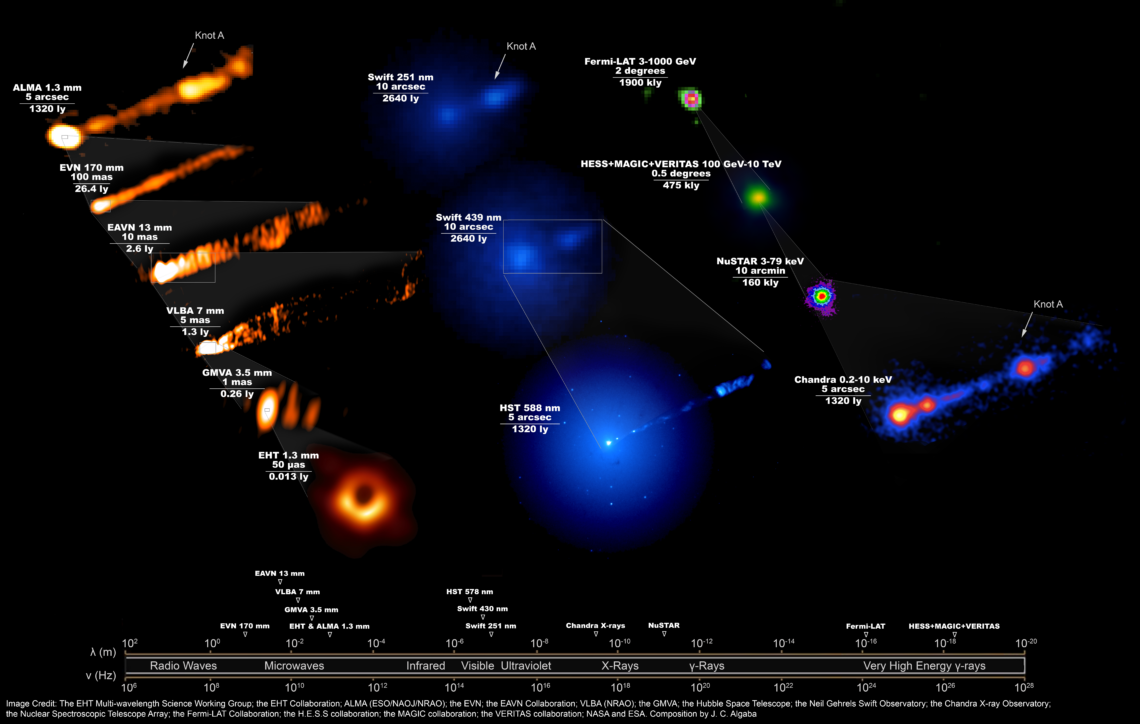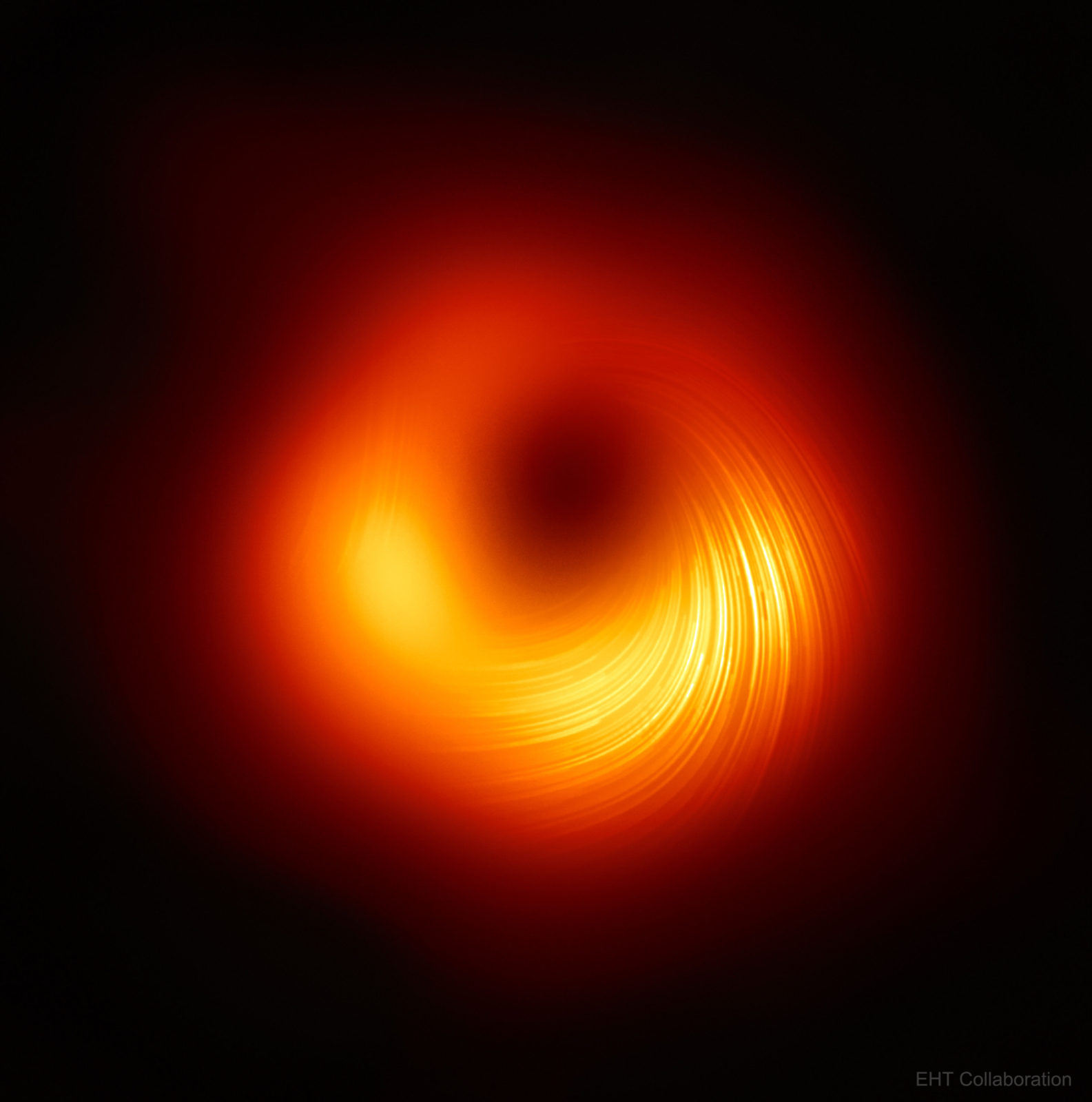It’s an exciting week in black hole-ville, as we are on the sky again with an even bigger and better Event Horizon Telescope (EHT) array, for the first time since 2018! At the same time, we are still only publishing results from our first major campaign in 2017. Why? Because our 2017 campaign was the first time anyone ever tried to use an Earth-sized telescope to make an image of a black hole, and that is technically extremely challenging. Each new result requires an enormous amount of work to develop, as well as significant vetting so we have confidence in what we publish. But as of this year, the results are starting to accelerate! Just a few weeks ago we published the first ever polarised images of the M87 black hole, which we covered in a group blog post here: https://www.seramarkoff.com/wp-admin/post.php?post=2754&action=edit. This study added a very important piece of the puzzle: it enabled us to quantify the strength and configuration of the magnetic fields near the black hole, which is a key ingredient for understanding the huge jets I’ll discuss below. However, these images cannot answer all our questions, becuase when we look in a single frequency (for EHT it’s 230 GHz in the submillimetre radio band) we miss out on other crucial information.
Today we just released a paper showing an expanded view of what M87 was doing at the moment we captured the image of its black hole in 2017. Specifically not just the black hole, but the enormous jets of particles and magnetic fields that it launches (we really only see the forward pointing jet for various reasons). We have many fundamental questions about these jets, like how can they possibly be launched at a speed close to the speed of light, and stay so straight and narrow while traversing the entire galaxy? To give you a sense of scales involved, we made a zoom out movie, along the lines of the Powers of Ten movie:
Are these massive jets getting an extra boost in power by tapping the black hole’s rotation energy, sort of like a turbine? If we could prove that, it would be another way to test General Relativity because it requires magnetic field lines to get dragged around with the spacetime around the black hole as it spins (“frame dragging”), a prediction of the theory.
Another big question has to do with what the jets are made of, and how the particles inside get energised. This energisation is the reason we can see the jets in all these different wavelengths as shown in the beauty shot compiled image at the top. The exact distribution of energy into the particles depends on the mechanism that bumps up their energy, so we can learn about that process by comparing the relative brightness and structures in all the different images. If jets are in fact the origin of the mysterious “ultrahigh energy cosmic rays”, very energetic heavy particles that bombard us from outer space, then we should see signs of their energisation sites, particularly in the highest energy gamma-rays. We did see gamma-rays, so then the question is whether they come from close to the black hole or further out in the jets. We want to know the answer, because it would help discern between competing models.
This paper represents the most extensive, simultaneous multi-wavelength campaign on M87, or any other jetted black hole as far as we know. The project was carried out by the EHT Multi-wavelength Science Working Group, which I co-coordinate together with Kazuhiro Hada from NAOJ in Japan, and Daryl Haggard from McGill University in Canada. The paper combines the efforts of 760 people, led by those on the primary author list, including our own former PhD student Dr. Matteo Lucchini!), and corresponding authors from the gamma-ray facilities. We also used 19 telescopes! I could write many blogs about how hard it is to organise these campaigns but I want to make a special shout out to the telescope schedulers, who have to do a lot of magic to get all the constraints to line up in a very tight window!
All the data are public so this is a legacy project for the community, you can find downloadable links at the journal: https://iopscience.iop.org/article/10.3847/2041-8213/abef71, and tomorrow on arXiv. Within EHT’s Theory and Simulation WG we will be using these new data as our best benchmark to help us improve the modelling of the complex physics around the M87 black hole.
Top image caption:
Composite image showing how the M87 system looked, across the entire electromagnetic spectrum, during the Event Horizon Telescope’s April 2017 campaign to take the iconic first image of a black hole. Requiring 19 different facilities on the Earth and in space, this image reveals the enormous scales spanned by the black hole and it forward-pointing jet, launched just outside the event horizon and spanning the entire galaxy.
(Credit: the EHT Multi-Wavelength Science Working Group; the EHT Collaboration; ALMA (ESO/NAOJ/NRAO); the EVN; the EAVN Collaboration; VLBA (NRAO); the GMVA; the Hubble Space Telescope, the Neil Gehrels Swift Observatory; the Chandra X-ray Observatory; the Nuclear Spectroscopic Telescope Array; the Fermi-LAT Collaboration; the H.E.S.S. collaboration; the MAGIC collaboration; the VERITAS collaboration; NASA and ESA. Composition by J.C. Algaba.)




